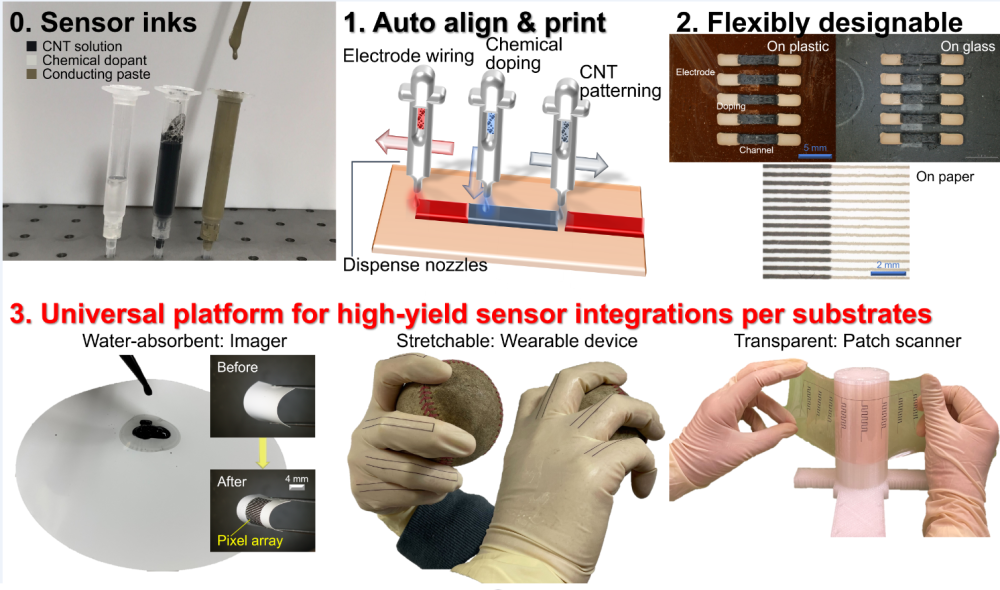2025.05.13
News
Spatially accurate & fast printing of testing sensors -Carbon nanotube photo-sensors onto arbitrary materials at a high-yield-
Summary
Led by Assistant Professor Kou Li, a research group in Chuo University, Japan, has developed an all-printable device fabrication strategy to resolve the existing technical limitations of multi-functional image sensor sheets for non-destructive inspections, with a recent paper publication in npj Flexible Electronics.
While photo-thermoelectric (PTE) sensors and their ultrabroadband monitoring facilitate non-destructive testing, their conventional fabrication is insufficient for high-yield integration. Specifically, PTE devices faced challenges in their crucial spatial-misalignment for separate fabrication processes per constituent. Herein, this work demonstrates mechanically alignable and all-dispenser-printable integration of carbon nanotube (CNT) functional PTE sensor devices by designing them with solution-processable ink-materials. This technique first accurately prints CNT channels, essential in PTE conversion, using higher-concentration inks, and integrates remaining constituents (dopants and conductive pastes) into single device structures at high-yield. This work further demonstrates that employing higher-concentration CNT inks, suitable for mechanical channel printing, also designs sensitive PTE sensors. These sensors serve stably as integrated devices on diverse functional substrates, facilitating ubiquitous non-destructive monitoring depending on features. Therefore, this work designs such CNT PTE integrated devices and the associated functional inspection appropriately for structures, sizes, and external environments (e.g., temperature and humidity) of monitoring targets.

Figure: Concept / By printing sensors on various substrate materials, unique functions specific to each can be realized.
While photo-thermoelectric (PTE) sensor sheets and their inherent omni-directional ultrabroadband monitoring facilitate functional material and structural identifying non-destructive testing, their conventional fabrication is insufficient for high-yield integration. Specifically, PTE devices faced challenges to large-scale integration for their crucial spatial-misalignment caused by separate fabrication processes of constituent parts.
To this end, this manuscript made the following significant contributions.
i) Preparing respective constituent materials of the functional PTE sensor sheets in liquid ink forms to be effectively adopted for all-solution-processable consecutive fabrication processes within a single platform as follows: carbon nanotube (CNT) photo-absorber channels, wiring electrodes, and carrier dopants.
ii) Developing high-yield formation and integration processes among each constituent part of the above CNT film PTE sensor sheet without conventionally bottlenecking manual spatial alignment steps by consistently handling all device inks with a single air-jet mechanical dispense printer.
iii) Demonstrating that the use of highly-concentrated CNT inks, which are essential in high-yield printing, collectively satisfies ultrabroad photo-detection operations over typical wideband detectors with comparable sensitivities to existing narrowband devices, as the core material role in the PTE sensor sheet.
iv) Enriching the usability of the CNT film PTE sensor sheets as ubiquitous inspection tools in diverse module configurations (e.g., high-resolution imagers, wearable gloves, and transparent patch-scanners) via universal and high-yield all-dispenser-printable device formations regardless of substrates.
The paper was published online in the international scientific journal, npj Flexible Electronics (May 8, 2025).
-Researcher-
| Kou Li |
Assistant Professor Faculty of Science and Engineering, Chuo University |
(Department of Electrical, Electronic, and Communication Engineering) |
| Minami Yamamoto |
Technical assistant Faculty of Science and Engineering, Chuo University |
(Department of Electrical, Electronic, and Communication Engineering) |
| Yukio Kawano |
Professor Faculty of Science and Engineering, Chuo University |
(Department of Electrical, Electronic, and Communication Engineering) |
| Daiki Sakai |
Master course student* *at the time of research Graduate School of Science and Engineering, Chuo University |
(Department of Electrical, Electronic, and Communication Engineering) |
| Yuto Matsuzaki |
Master course student* *at the time of research Graduate School of Science and Engineering, Chuo University |
(Department of Electrical, Electronic, and Communication Engineering) |
- Paper information -
| Journal: | npj Flexible Electronics |
| Title: | Mechanically alignable and all-dispenser-printable device design platform for carbon nanotube-based soft-deformable photo-thermoelectric broadband imager sheets |
| Author: |
Minami Yamamoto†,1, Daiki Sakai†,1, Yuto Matsuzaki†,1, †Co-first author *Corresponding author |
| Affiliation: |
1Department of Electrical, Electronic, and 2Laboratory for Future Interdisciplinary 3Department of Electrical and Electronic 4National Institute of Informatics 5Kanagawa Industrial Institute of Scienceand Technology |
| DOI: | 10.1038/s41528-025-00419-2 |
- Acknowledgement -
The authors acknowledge Zeon Co. and Tokushiki Co. Ltd. for providing aqueous CNT dispersions and THz–IR-transparent black-coloured inks. The authors also thank Musashi Engineering Inc. for their technical support. This work was financially supported by a part of ACT-X (JPMJAX23KL) and Mirai Programme (JPMJMI23G1): JST, KAKENHI (JP22H01553, JP22H01555, JP23H00169, JP23K19125, JP24K01288, and JP24K17325): JSPS, and grants (Murata Science Foundation, Matsuo Foundation, Sumitomo Electric Groups CSR Foundation, Takano Science Foundation, Thermal & Electric Energy Technology Foundation, Precise Measurement Technology Promotion Foundation, Suzuki Foundation, Iwatani Naoji Foundation, Futaba Foundation, Konica Minolta Science and Technology Foundation, Fuji Seal Foundation, Telecommunications Advancement Foundation, TEPCO Memorial Foundation, Paloma CSR Foundation, Takano Life Science Research Foundation, The Foundation for The Promotion of Ion Engineering, Hattori Hokokai Foundation, Mechanical Social Systems Foundation, Kayamori Foundation of Informational Science Advancement, Shimadzu Science Foundation, Japan Power Academy, Tokuyama Science Foundation, Yashima Environment Technology Foundation, Tateisi Science and Technology Foundation, The Kajima Foundation, Japan Keirin Autorace Foundation, Amano Institute of Technology, and Kanagawa Institute of Industrial Science and Technology). K.L., D.Sa., and Y.Ka. conceptualised this work and coordinated the experiments. M.Y., D.Sa., Y.M., and K.L. wrote the manuscript. M.Y., D.S., Y.M., L.T., Y.Ko., Y.A., N.I., N.H., H.H., D.Si., J.J., Q.Z., K.M., Y.Ki., S.Y., N.T., H.N., and K.L. performed the experiments.
- Acknowledgement -
Kou Li
Assistant Professor
Department of Electrical, Electronic, and Communication Engineering,
Faculty of Science and Engineering,
Chuo University
TEL: +81-03-3817-1870
E-mail: li▲elect.chuo-u.ac.jp
* Please replace ▲ with @ when sending email.
- General Inquiry -
Research Promotion Office,
Chuo University
E-mail: kkouhou-grp▲g.chuo-u.ac.jp
* Please replace ▲ with @ when sending email.
